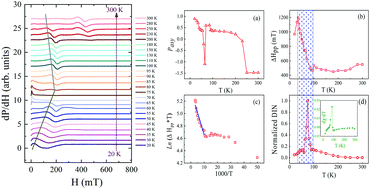Spin reorientation transition and spin dynamics study of perovskite orthoferrite TmFeO3 detected by electron paramagnetic resonance†
Abstract
The temperature-dependent spin-reorientation transition (SRT) and spin interaction mechanism of bulk TmFeO3 were studied by the electron paramagnetic resonance (EPR) method. The combined experimental results of magnetic curves and EPR spectra confirmed that there is an antiferromagnetic transition at 85 K with a reentering ferromagnetic state due to the spin-reorientation behavior. In the high-temperature region of T > 90 K, there are three distinct resonance peaks in the EPR spectrum, which indicates the presence of multiple magnetic phases (canted antiferromagnetic, weak ferromagnetic, and paramagnetic phases). In the low-temperature region (T < 85 K), the temperature dependence of the EPR linewidth, effective g-factor, and intensity can be used to infer a strong spin–lattice correlation. Different magnetic interactions such as Fe3+–Fe3+, Fe3+–Tm3+, and Tm3+–Tm3+ lead to a paramagnetic–canted antiferromagnetic phase at T > 85 K, with SRT between 85–65 K and ferromagnetic interaction at the lower temperature, respectively. Above 90 K, we find that the spin relaxation mechanism is determined by the mixture of spin–spin and spin–lattice interactions. Below 85 K, the transverse relaxation rate increases with the decrease in temperature, which is consistent with the weakening of the fluctuating internal field in this temperature region. This EPR detection provides a new method to clarify the strong spin coupling in antiferromagnetic materials.



 Please wait while we load your content...
Please wait while we load your content...